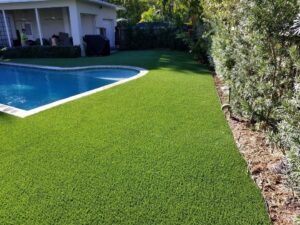Artificial turf has become an increasingly popular option for homeowners and businesses looking for a low-maintenance, green outdoor space. However, before installing artificial grass, there are several factors to keep in mind to ensure the best results. Here’s a guide on what to consider when looking into artificial turf installation:
1. Purpose of the Turf
The first thing to consider is how the turf will be used. Are you installing it for a residential lawn, a sports field, a pet area, or a playground? Different types of synthetic grass are designed for different applications. For instance:
- Residential Lawns: These focus on aesthetics and are designed to mimic the look and feel of natural grass.
- Sports Fields: Turf for sports fields is designed for durability and performance under heavy foot traffic.
- Pet Areas: Turf for pets should have excellent drainage and antimicrobial properties to prevent odors and bacterial growth.
Understanding your primary use will help you choose the right type of turf for your needs.
2. Turf Material
Not all artificial grass is created equal. The material used for the turf fibers can greatly affect the performance and appearance. The three most common types of materials are:
- Polyethylene: Known for its softness and realistic appearance, polyethylene is commonly used for residential lawns. It offers a good balance of durability and aesthetics.
- Nylon: The strongest of all turf materials, nylon can withstand high temperatures and heavy use, making it ideal for sports fields and high-traffic areas.
- Polypropylene: The most budget-friendly option, but it is less durable and may not be suitable for areas that experience heavy use or extreme weather conditions.
3. Pile Height
The pile height refers to the length of the individual blades of grass. The ideal pile height depends on the intended use:
- For residential lawns, a pile height of around 30-37mm offers a lush, natural appearance.
- For sports or play areas, shorter pile heights around 10-25mm provide more durability and functionality.
- Pet-friendly turf usually has a shorter pile height for easier cleaning and maintenance.
4. Backing and Infill
The quality of the turf backing is crucial for stability and durability. You want a backing that is sturdy but flexible enough to allow for proper drainage. Most backings are made of polyurethane or latex.
Infill, a material added between the turf blades, is another important consideration. Infill provides cushioning, helps maintain the structure of the blades, and adds weight to keep the turf in place. Common infill materials include:
- Sand: Provides weight and helps blades stay upright, but may retain more heat.
- Crumb Rubber: Offers more cushioning but can absorb heat and may have an odor.
- Organic Materials: Options like cork or coconut fibers are eco-friendly and offer a cooler surface temperature but may break down over time.
5. Drainage Capabilities
Good drainage is essential, especially in areas prone to heavy rainfall or where pets will use the space. Proper drainage prevents water pooling, mold, and odors. Ensure that your chosen turf has perforations in the backing to allow water to flow through easily. Additionally, the base preparation should include a layer of crushed stone or gravel to assist in drainage.
6. Climate Considerations
The climate in your region will also impact the type of artificial turf you choose. In hot climates, some artificial grasses can retain heat, making them uncomfortable to walk on. Look for turf with cooling technology or lighter-colored fibers to reflect heat. In cooler or wetter climates, you’ll want to focus on drainage and moisture resistance to prevent mold or moss buildup.
7. Maintenance Requirements
While artificial turf requires less maintenance than natural grass, it’s not entirely maintenance-free. Consider the following:
- Brushing: To keep the blades upright, you’ll need to brush the turf periodically, especially in high-traffic areas.
- Cleaning: For pet areas, cleaning with a hose and using special pet-friendly turf cleaners may be necessary to prevent odors.
- Weed Prevention: Occasionally, weeds may grow through the turf backing, so a weed barrier or routine spot treatment might be required.
8. Budget and Installation Costs
While artificial turf saves money in the long run by eliminating the need for watering, mowing, and fertilizing, the initial installation can be costly. Consider both the cost of materials and the professional installation. While DIY installations are possible, professional installation ensures proper preparation of the base, drainage, and a seamless, long-lasting finish.
9. Warranties and Lifespan
Check the warranties offered by different turf manufacturers and installers. A good artificial turf product should last anywhere from 8 to 15 years, depending on the quality of materials and the level of traffic. Warranties often cover fading, wear, and defects, so ensure you’re getting sufficient coverage for your investment.
10. Environmental Impact
If sustainability is a priority, consider the environmental impact of the turf. Some artificial grass products are made from recycled materials, and certain infill options are more eco-friendly. Additionally, artificial turf can help conserve water and eliminate the need for chemical fertilizers, making it a greener choice over time.
Conclusion
Choosing the right artificial turf for your installation involves more than just picking the best-looking grass. From material and drainage to maintenance and cost, each factor plays a crucial role in determining the longevity and success of your turf. By carefully considering these aspects, you’ll be able to create a beautiful, low-maintenance, and functional outdoor space tailored to your needs.

